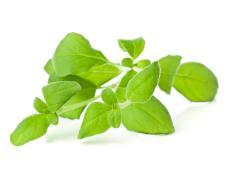Herb of the Month: Rosemary

Fresh herbs are becoming tougher to find as the weather becomes colder. Luckily, rosemary is still available, so grab a bunch while you still can!
This symbol of love and fidelity is a member of the mint family. It has needle-shaped leaves that are very fragrant with hints of both pine and lemon. Rosemary is native to the Mediterranean, but today is grown in France, Spain, and the United States where California is the main grower of the herb. Popular varieties for cooking include “Tuscan Blue,” “Spice Island,” and “Miss Jessup.”
A tablespoon of fresh rosemary has only 2 calories but tons of nutrients like vitamin A, C, iron, and manganese. The herb also contains several plant compounds called polyphenols, which have been shown to have antioxidant activity.
Several studies have shown that rosemary extract helps reduce the spread of leukemia. Rosemary oil has also been shown to help decrease the growth of E. Coli and possibly other bacteria in food.
Rosemary is most fragrant in its fresh form, though you can find it dried, powdered and as an oil. It’s commonly used to flavor Mediterranean dishes as well as wines and ales. Use rosemary to season fruit salad, lamb dishes, chicken, soups, egg dishes, rice dishes, stuffing and salad dressings. You can also make a killer rosemary-infused oil (a great gift for the upcoming holidays).
To savor the goodness of fresh rosemary a bit longer, freeze it: Wash, trim, and chop rosemary. Spread out on a paper towel and let dry. Then place in a freezer safe plastic bag. You can also place the chopped rosemary in an ice cube tray and mix with a touch of water. Once frozen, pop out ice cubes and store in a freezer-safe bag.
Shopping Tip: Choose fresh rosemary that is bright in color. To store, wrap in a damp cloth and place in a plastic bag in the refrigerator for up to 5 days.


































